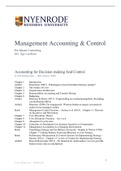Summary
Samenvatting Management Accounting & Control - Nyenrode
- Course
- Institution
- Book
This summary covers the relevant chapters of Zimmerman's Accounting for Decision Making And Control book, as well as a number of articles/books that are part of the compulsory subject matter, namely: - Brewer (2007) - Police officer or just a committed business partner? - Bouwens & Kroos (2017):...
[Show more]



